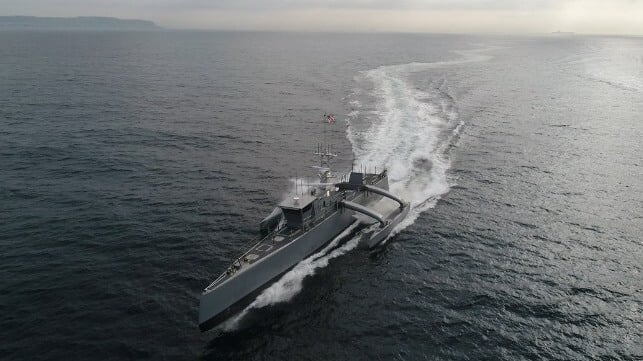U.S. Navy Growth Plan: Retire Unwanted Ships, Add 150 Uncrewed Vessels

The U.S. Navy has released another update of its long-range shipbuilding plans, which have been a source of friction between the Navy, the other service branches and congressional officials in recent years. The service's top-line numbers now stand at 350-plus conventional ships and 150 uncrewed vessels, for a combined fleet size of about 500.
The top line roughly aligns with the Battle Force 2045 plan, created by the Pentagon in the final days of the Trump administration. Then-Secretary of Defense Mark Esper's program called for a larger fleet of smaller crewed vessels: 8-11 supercarriers, six new "light carriers," 20 more frigates/small combatants, and 10-20 fewer destroyers (plus dozens of extra subs). This 400-ship fleet would be supplemented with 140-240 uncrewed platforms. But after Esper's departure, the Navy has gone through a series of plans in a back-and-forth with Congress, which has been skeptical about proposals for uncrewed vessels.
On Tuesday, Chief of Naval Operations Adm. Mike Gilday released a new vision, Force Design 2045. Its first message is to call for decommissioning "legacy platforms that cannot stay relevant in contested seas," a reference to the Navy's proposal to retire Freedom-class LCS vessels and Ticonderoga-class cruisers. Gilday has advocated for removing these ships from the Navy's balance sheet, then reinvesting the funds in new platforms for the high-end fight.
The CNO's shipbuilding plan for 2045 envisions a full-size conventional fleet of 350-plus crewed ships. This includes a full-size force of 96 destroyers, 66 attack subs and 12 supercarriers. The plan also includes all 31 full-size amphibs wanted by the Marine Corps, plus 18 small-size amphibs for island-to-island operations.
Like Esper's plan, Force Design 2045 still relies on a fleet of 150 uncrewed systems to reach the top line number of 500. These uncrewed surface vessels and subs are a key part of the proposal: they would spread the force's capabilities out over more platforms, conduct ISR, carry extra missiles to supplement destroyers' magazines, and provide logistics support.
All of this will be expensive. "To simultaneously modernize and grow the capacity of our fleet, the Navy will require 3-5 pecent sustained budget growth above actual inflation," wrote the CNO. If Congress can't find the funds for real budget growth, "we will prioritize modernization over preserving force structure," he advised. In other words, if extra funds aren't available, the service may have to high-grade the fleet and allow its total size to decline.
"Get Real, Get Better"
Force Design 2045 was released within a broader annual advisory to the fleet, Navigation Plan 2022. The NAVPLAN is focused as much on human performance as on platforms, and reiterates Gilday's order to "get real, get better." The Navy has sustained three major casualties since 2017, all caused by human error - including one billion-dollar total loss.
"The gap between our best and worst performers is too great," wrote Gilday. "[We must] reduce this variability and unleash our full potential."
The "get real" order requires leaders from the deckplate up to "ruthlessly self-assess; be honest, humble, and transparent about their capabilities and limitations; challenge their beliefs using data, facts, and diverse input; and . . . fix the root causes, not just symptoms."
